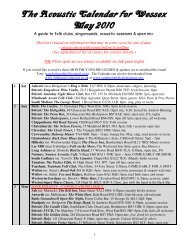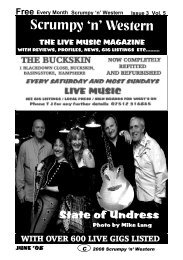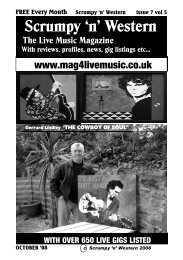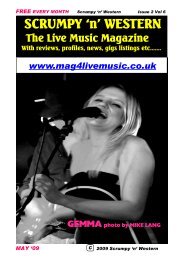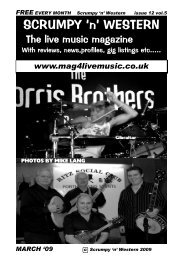with over 650 live gigs listed - Mag 4 Live Music
with over 650 live gigs listed - Mag 4 Live Music
with over 650 live gigs listed - Mag 4 Live Music
Create successful ePaper yourself
Turn your PDF publications into a flip-book with our unique Google optimized e-Paper software.
FREE EVERY MONTH Scrumpy ‘n’ Western EXTRA<br />
FACTS ABOUT AMPLIFIERS<br />
Or did you know Part one<br />
If you use an electric guitar or electro<br />
acoustic then you will be using an amplifier<br />
which will come in various sizes from a<br />
small 10 watt practice to anything larger!!<br />
This article is really to give you a better<br />
idea of what you are really using and my be<br />
of help <strong>with</strong> a bigger purchase in the future.<br />
An amplifier takes a tiny electrical current<br />
and turns it into a much bigger current that<br />
will move loudspeaker cones. The first devise<br />
that could do this was a valve, and the<br />
‘amplification tube’ was patented in about<br />
1906 (oddly enough by two people , who<br />
were working on the same idea but independently.)<br />
The early audio amplifiers were<br />
huge devices <strong>with</strong> each section of the circuit<br />
forming a separate unit in a rack. The<br />
first known electric guitar design dates<br />
back to the early thirty’s, but the first purpose-built<br />
guitar amplifiers appeared in<br />
America in the 1940’s and were modified<br />
from radio set circuits. Leo Fender had<br />
started ‘Fender Radio Services’ in the early<br />
1940’s as Radio was the then modern<br />
technology of it’s day. The first guitar amplifier<br />
to use transistors, available to buy<br />
commercially was the Burns Orbit combo,<br />
made in Britain about 1963 (Burns being a<br />
top UK brand) The 40 watt combo sported<br />
a tremolo circuit and there were a number<br />
of variations, based on different speakers.<br />
At that time, this ground breaking design<br />
was more expensive than the valve combos<br />
on sale at the time! Where as today a<br />
valve combo will cost far more. Today guitarists<br />
spend a lot of time arguing <strong>with</strong><br />
other guitarists whether valve amps are<br />
‘better’ than the many modern designs that<br />
seek to emulate the valve sound. This<br />
could be a complete waste of time as for a<br />
number of reasons like better could mean<br />
to be far more reliable in use or a better<br />
range of tones and many other possible,<br />
undefined criteria.<br />
This could be down to a personal thing, but<br />
generally most top guitar players will use<br />
valve as a better sound. Even the term<br />
‘valve’ is misleading, because they are<br />
NOVEMBER ‘08 29<br />
used in very different ways, in different<br />
designs. As the name states, a valve really<br />
does regulate a flow in a valve amp, but it’s<br />
a flow of electrons, not water. Inside the<br />
valve is a cathode and a plate, <strong>with</strong> a grid<br />
in between. Electrons flow from the cathode<br />
to the plate. The grid in between controls<br />
the flow of electrons, hence the<br />
valve-like action. The cathode has to be<br />
warmed for this to happen, so there is a<br />
small heater at the bottom of each valve.<br />
This is what you are turning on when you<br />
put the amp into standby. Very small voltages<br />
applied to the grid cause big changes<br />
in the electron flow (current) between the<br />
cathode and the plate, that’s amplification.<br />
The voltages are determined by a variable<br />
input, an electric guitar! You might assume<br />
that when you’re not playing at all, the grid<br />
is at ov but this is not so. In a power valve,<br />
it is likely to be somewhere around - 40v.<br />
The precise voltage used varies from case<br />
to case and is called the ‘bias setting’.<br />
In a Class A circuit, the valve is never idle.<br />
The bias is set so that the valve is passing<br />
current at all times. The first known class A<br />
guitar amp is the Vox AC15, introduced in<br />
1956. Class B amps can produce a lot<br />
more power than class A. They use two<br />
power valves in a push pull configuration or<br />
multiples of these pairs for higher powered<br />
configurations. One of the pair handles the<br />
positive side of the wave form, while the<br />
other handle the negative. The bias is set<br />
so that the valve is idle in between times.<br />
In reality, this arrangement doesn’t sound<br />
so good because there is unwanted distortion<br />
of the waveform at the cross<strong>over</strong> point<br />
where one valve stops working and the<br />
opposite half of the pair kicks into life.<br />
We will continue next month, meanwhile if<br />
you are looking to purchase a new amplifier<br />
remember guitars do have a sound of<br />
their own, take your guitar <strong>with</strong> you when<br />
buying a new amp, for you could try out in<br />
the shop using one of theirs, get home and<br />
find you are not satisfied <strong>with</strong> the sound!!<br />
A good music shop will want you to buy<br />
what you are looking for, since there is the<br />
repeat business, of strings etc.....




